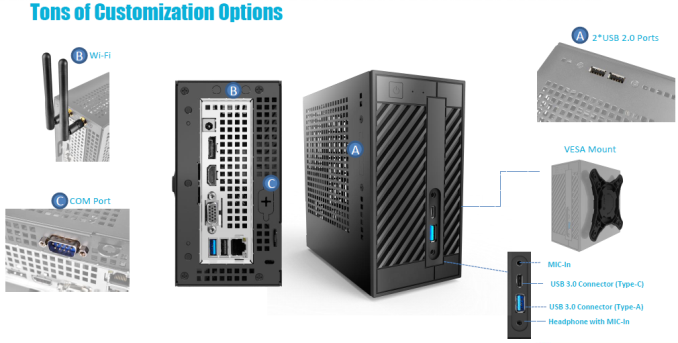ASRock DeskMini 110 mini-STX PC Review
by Ganesh T S on June 8, 2016 8:45 AM ESTConcluding Remarks
The ASRock DeskMini 110 gave us the opportunity to check out what is possible with the mini-STX form factor and a high-TDP Skylake CPU. It is quite clear that Intel's current marketing angle with the mini-STX form factor is affordability. Otherwise, it is difficult to explain why almost all vendors have gone in for a H110 chipset-based design for their mini-STX offerings. That said, ASRock has put in a couple of good differentiating aspects in the DeskMini 110: support for 65W TDP CPUs and a M.2 PCIe slot for SSDs directly connected to the CPU's PCIe lanes. This works around the issue of the H110 chipset having only PCIe 2.0 lanes
The pricing is very competitive - $130 for the all-metal chassis, 120W power adapter and cord, and the H110 motherboard. While the assembly is not as easy as that of a NUC, it is acceptable for the DIY market.
In terms of scope for improvement, a bundled WLAN adapter would be very welcome. Sourcing one that can fit in with the chassis design will be a challenge, as most M.2 PCIe WLAN modules are either meant for NUCs, or for notebooks. The DeskMini's all-metal chassis makes it difficult to get a suitable placement for the flat antennae that come with such WLAN adapters. I think it would be better for ASRock to bundle / pre-install a WLAN module and antennas for a slight increase in the price of the product. The DeskMini could also do with some additional I/O (say, a SD card reader).
It is great to see the mini-STX form factor getting broad vendor support. We would like it more if vendors were able to differentiate their offerings. ASRock has tried out a few things differently in the storage subsystem and chassis design with the DeskMini 110. We look forward to seeing what other differentiation aspects come out in the future iterations in this product line.












85 Comments
View All Comments
nonotme2 - Wednesday, June 8, 2016 - link
Are there any XEON based sfx platforms?CSMR - Wednesday, June 8, 2016 - link
The form factor has a lot of potential, but:1. Mobo makers are stuck in the past. Wasting space with VGA output which could have gone to more USB3 ports or an extra displayport or thunderbolt.
2. Please give us at least the graphics power you can get in NUCs or Brix systems with Iris Pro. The 65W processors with shared-memory graphics are unbalanced with strong CPU and weak GPU. Quad-core Iris Pros are great all-rounders but stretch the cooling systems of NUCs and Brixes.
cm2187 - Wednesday, June 8, 2016 - link
Out of curiosity, what would happen if I stick an i7 6700K in there (no overclocking)? Is it a temperature or a power constraint?fanofanand - Wednesday, June 8, 2016 - link
likely both.BedfordTim - Wednesday, June 8, 2016 - link
It will take an i7-6700 which would make more sense if you are not overclocking.extide - Monday, June 13, 2016 - link
Those have a higher TDP -- that board may not support them. It supports 65w for sure, but maybe not the higher wattage of the K series chips, which I think is 91w.A5 - Wednesday, June 8, 2016 - link
Would be interesting to mix this kind of thing with an R-series CPU if you need to do (very) light gaming.The_Assimilator - Wednesday, June 8, 2016 - link
Man, this thing would be a killer if it had Thunderbolt support.wintermute000 - Wednesday, June 8, 2016 - link
Can someone pretty please test ESXi on it :)wintermute000 - Wednesday, June 8, 2016 - link
And kvm too ;)